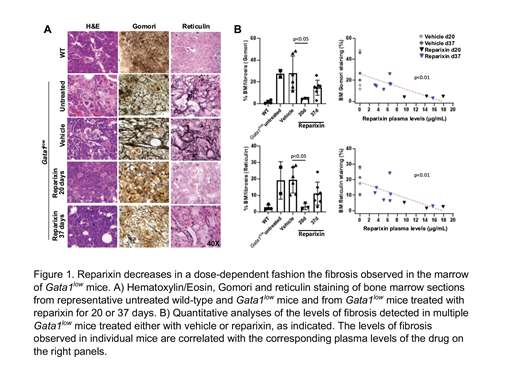Abstract
A mayor pathobiological role for interleukin 8 in the etiology of myelofibrosis has been suggested by observations indicating that megakaryocytes expanded in culture from these patients express great levels of interleukin 8 1 and that the plasma levels of this cytokine are predictive of poor prognosis 2. In preliminary experiments we demonstrated that the megakaryocytes from the bone marrow of the Gata1 low model of myelofibrosis express not only high levels of TGF-β, but also levels greater than normal of lipokalin-2, a known inducer of IL-8 production, and of CXCL1, the murine equivalent of IL-8. In addition, these megakaryocytes express also high levels of the CXCL1 receptors CXCLR1 and CXCR2 and the bone marrow from these mice express an CXCR1/CXCR2 activated signature. Using these data as a foundation, we tested here the effects of treatment of Gata1 low mice with the CXCR1/R2 inhibitor reparixin on the myelofibrosis phenotype expressed by this models. To these aim, Gata1 low mice (8-month old) were treated either with vehicle (3 males and 3 females) or with reparixin (formerly referred to as repertaxin) 3 (5 males and 5 females) for either 20 or 37 days. The drug was administered by minipumps implanted subcutaneously in the dorsal region set to deliver 7.5mg of drug/hr/Kg of body weight. The mice receiving the drug for 37 days had the minipumps replaced by day 17. The efficiency of drug delivery decreased over time since the plasma levels of reparixin were 13.90±4.18 and 6.71±4.18ug/mL at day 20 and 37, respectively (p<0.05).The drug was well tolerated with no death or change in body weight recorded over the period of observation. Since the results observed in males and females were similar, the data were pooled for statistical analyses. The treatment did not affect blood values (hematocrit (%): 34.32±3.87 vs 35.63±3.45 and 30.92±3.58, platelets: (x10 3/uL) 187.80±26.12 vs 181.30±53.30 and 99.83±71.92 and white cell counts (x10 3/uL): 2.78±0.55 vs 3.27±0.72 and 3.57±1.43, respectively, in vehicle and day 20- or day 37-reparixin treated mice). The treatment had also little effects on bone marrow (20.55±5.83 vs 22.24±0.85 and 21.68±6.49) and on spleen 141.40±29.04 vs 99.54±15.55 and 173.00±76.54) cellularity. However, the bones were reddish and their sections contained great numbers of erythroid cells, a sign of increased hematopoiesis. Great reductions in the fibrosis of the bone marrow and spleen was observed in mice that had been treated with reparixin compared to vehicle which were statistically significant by day 20 (day 20 bone marrow fibrosis 28.09±15.69 in vehicle and 4.54±0.45 in reparixin treated mice by Gomori, p<0.05; 19.30±7.86 vs 3.19±1.89 by reticulin, staining, p<0.05, respectively by Anova; day 20 spleen fibrosis 20.51±5.25 in vehicle and 10.85±3.82 in reparixin treated mice by Gomori, p<0.05; and 13.15±3.06 vs 6.13±2.34 by reticulin, staining, p<0.05, respectively). Of note when the levels of Gomori and reticulin fibrosis detected at day 20 and 37 in individual mice were inversely correlated with the plasma levels of reparixin observed in the same mice (Figure 1, p<0.01-0.05 by Pearson). Mechanistic insights on these results were provided by Immunostaining of marrow and spleen sections of vehicle and reparixin-treated mice indicating that the megakaryocytes from the reparixin-treated group express levels of TGF-β significantly lower than those expressed by the corresponding cells from vehicle while the levels of LCN-2, CXCL1, CXCR1 and CXCR2 expressed by the reparixin treated megakaryocytes are similar to that of the vehicle treated cells. These results indicate that inhibition of CXCL1 by reparixin, probably by reducing the abnormally high TGF-β content of the megakaryocytes, reduces fibrosis in Gata1 low mice and provide a preclinical rational to test this drug in patients with myelofibrosis.
References: 1) Emadi S et al. Blood. 2005;105:464; 2) Tefferi et al, J Clin Oncol. 2011;29:1356; 3) Bertini R et al, PNAS 2004; 101:11791
Crispino: Forma Therapeutics: Research Funding; Scholar Rock: Research Funding; MPN Research Foundation: Membership on an entity's Board of Directors or advisory committees; Sierra Oncology: Consultancy. Massucci: Dompe Farmaceutici Spa R&D: Current Employment. Brandolini: Dompe farmaceutici Spa R&D: Current Employment. Giorgio: Dompe farmaceutici Spa R&D: Current Employment. Allegretti: Dompe farmaceutici Spa R&D: Current Employment. Migliaccio: Dompe farmaceutici Spa R&D: Other: received funding for reserach .


This feature is available to Subscribers Only
Sign In or Create an Account Close Modal